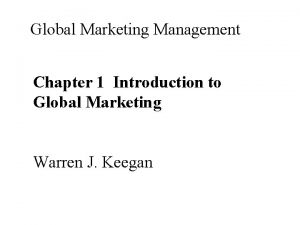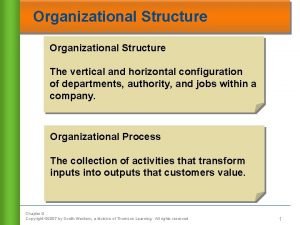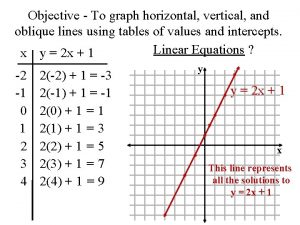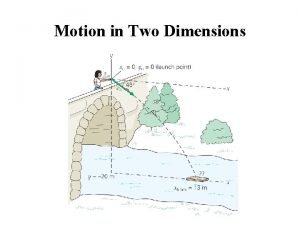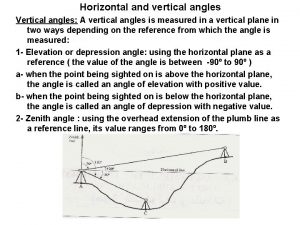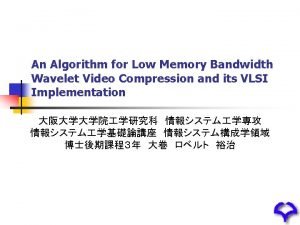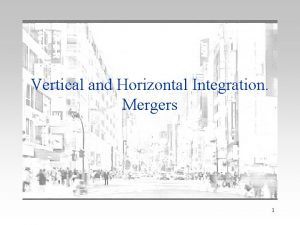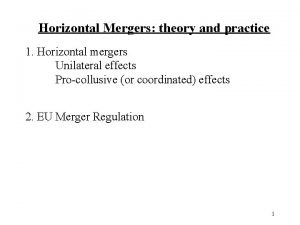Horizontal and Vertical Agreements restraining competition References Faull





























- Slides: 29

Horizontal and Vertical Agreements restraining competition

References Faull & Nikpay: The EC Law of Competition. 2 nd Ed. Oxford University Press, 2007 Bellamy, Child, G. European Community Law of Competition. 6 th Ed. London: Sweet & Maxwell, 2008. The Treaty on the functioning of the European Union Guidelines on the applicability of Article 101 of the Treaty on the Functioning of the European Union to horizontal cooperation agreements Text with EEA relevance - 2011/C 11/01 Guidelines on Vertical Restraints (2010/C 130/01)

� Horizontal agreements = agreements between undertakings at the same level of supply � Vertical agreements = agreements between a supplier and an acquirer at a different level of the production or distribution chain � They both may be addressed under Art. 101/1 TFEU if they establish or are part of an agreement, a concerted practice or a decision by an association of undertakings which may affect trade between Member States and which have as their object or effect the prevention, restriction or distortion of competition within the internal market � Classification: � “per-se” (hard-core) – illegal in themselves – price fixing cartels, … � “non per-se” – not necessarily harmful to competition, their effect depends on particular circumstances as the nature of the agreement and market conditions � They both may be addressed under Art. 101/3 TFEU (possible economic benefits) and block exemption regulations

1. Horizontal agreements Guidelines on the applicability of Article 101 of the Treaty on the Functioning of the European Union to horizontal co-operation agreements Text with EEA relevance - 2011/C 11/01 („Guidelines“) � Horizontal co-operation = co-operation between actual and potential competitors (horizontal co-operation may also cover agreements between non-competitors – for example companies in the same product market but in different geographic market) � Horizontal co-operation may lead to economic benefits and also to competition problems � Economic benefits: Ø Ø combination of complementary activities, skills or assets → they enable to share risk, save costs, increase investments, pool know-how, enhance product quality and variety, and launch innovation faster Competition problems: � Ø Ø price fixing, output limitation, market sharing If the parties have together a strong market power → negative market effects with respect to prices, output, product quality, product variety or innovation

The main competition concerns � Horizontal co-operation agreements may : � limit the possibility of the parties to compete against each other or third parties � reduce decision making independence of the parties � affect the parties’ financial interests � lead to the disclosure of „strategic information“ and thereby increasing the likelihood of cooperation among the parties within or outside the field of the cooperation � achieve significant commonality of costs → parties may more easily coordinate market prices and output � The restrictive effect of an agreement depends on a market power of the parties and a characteristics of the relevant market � What characteristics are relevant for the assessment of an agreement? � market shares of the parties, � whether the parties are close competitors, � whether the customers have limited possibilities of switching suppliers, � whether competitors are unlikely to increase supply if prices increase, � whether one of the parties to the agreement has an important competitive force, �…

Joint Ventures („JVs“) � JVs = agreements by which two or more independent undertakings proceed to a partial integration of their business operations which are put under join control in order to achieve some commercial goal � the main features: � limited integration of operations � preservation of the economic independence of companies � concentrative JVs (fall within Merger Regulation) x co-operative JVs (may fall within the scope of Art. 101/1) � possible restriction of competition depends on: � the nature of the product manufactured or the services offered, input of the JV, production of the JV, sales by the JV, risk factor (could each partner bear the technical and financial risks associated with the production of the JV alone? )

Forms of horizontal agreements � The classification under the Guidelines a) Information exchange b) Research and Development Agreements c) Production Agreements d) Purchasing Agreements e) Agreements on Commercialization f) Standardization Agreements � Other possible classification: � Agreements on Price and Trading conditions (Price fixing, Agreements on other trading conditions, Professional services, …) � Output Restrictions (Limitation of output, Limitation of production, …) � Market sharing and Customer Allocation (Joint selling agreement, Joint buying agreement, Bilateral market-sharing, Sharing access to infrastructure or facilities, …) � Collective trading arrangements (Boycotts and collective exclusive dealing, Collective selling of goods, …) � Trade associations, cooperatives and exhibitions (Membership rules, Common standards)

a) Information exchange (1) � Forms of information exchange: � data can be directly shared between competitors, � data can be shared indirectly through a common agency (as a trade union) or a third party (such as a market research organization or companies' supplier or retailer) � „Strategic information“ (their exchange can be more likely viewed as anticompetitive) � data that reduces strategic uncertainty in the market → usually related to prices, customer lists, production costs, quantities, turnovers, sales, capacities, qualities, marketing plans, risks, investments, technologies and R&D programmes and their results � It is important to assess: � level of details, public/non-public information � historical information (they usually not fall within Art. 101/A) / recent data / future data � frequency of information exchange

Information exchange (2) Competition concerns: Undertaking are aware of market strategies of other competitors → it facilitate the coordination of companies' competitive behavior → companies are aware of intentions concerning each others' future conduct Creation of „monitoring mechanism“ both past and present data exchange may facilitate the implementation of a cartel → the parties may monitor the compliance of other members with the agreed terms to increase the external stability of a collusive outcome on the market Possible efficiency gains (Art. 101/3 TFEU): elimination of information asymmetries improvement of the companies' internal efficiency through benchmarking against each other 's best practice saving costs by reducing their inventories benefits for consumers by reducing their search costs and improving choice

Information exchange (3) Judgment of the Court of Justice in Case C-8/08 T-Mobile Netherlands BV and Others […] information between competitors pursues an anti-competitive object if it is capable of removing uncertainties as to the anticipated conduct of the participating undertakings […] Only a single meeting between companies may constitute an anticompetitive concerted practice […] what matters is not so much the number of meetings held between the participating undertakings as whether the meeting or meetings which took place afforded them the opportunity to take account of the information exchanged with their competitors in order to determine their conduct on the market in question and knowingly substitute practical cooperation between them for the risks of competition […]

b) Research and Development (R&D) Agreements (1) � R&D agreements may have many different forms: � outsourcing certain R&D activities, � joint improvement of existing technologies, � co-operation concerning the research, development and marketing of completely new products, … � The definition of the relevant market is important � Existing product market / existing technology market (consist of IP which is licensed) � In most cases, R&D agreements are not anticompetitive (application of Regulation No 1217/2010 on the application of Article 101(3) of the TFEU to certain categories of research and development agreements)

R&D Agreements (2) Competition concerns: R&D Agreements may reduce or slow down innovation They may reduce competition between the parties and they make anticompetitive co-ordination which leads to higher prices R&D Agreements which contain joint exploitation of the possible result are more likely anticompetitive The anticompetitive outcome is likely if the parties together have a strong market position R&D co-operation may not only affect competition in existing markets but also competition in new product markets Efficiency gains: The costs and risks associated with R&D are usually very high → the co- operation is good to spread these risks They combine complementary skills and assets → new products and technologies can be developed and marketed more rapidly

c) Production agreements (1) � Horizontal subcontracting agreements (the „contractor“ entrusts to the „subcontractor“ the production of a good) � Unilateral specialisation agreements = „agreements between two parties which are active on the same product market, one party agrees to fully or partly cease production of certain products or to refrain from producing those products and to purchase them from the other party, which agrees to produce and supply the products“ � Reciprocal specialization agreement = „two or more parties agree, on a reciprocal basis, to fully or partly cease or refrain from producing certain but different products and to purchase those products from the other parties, which agree to produce and supply them“ � Subcontracting agreements with a view to expanding production = „the contractor entrusts the subcontractor with the production of a good, while the contractor does not at the same time cease or limit its own production of the good“

Production agreements (2) Competition concerns: Alignment of the output level, the quantity, the price and other competitively important parameters Coordination of parties' behavior as suppliers leading to higher prices or reduced output, product quality, product variety or innovation Possible anti-competitive foreclosure of third parties in a related market (e. g. , downstream market ) Direct limitation of competition between the parties → limitation of the outputs, higher downstream prices, … A production agreement can have restrictive effects on competition if it increases parties' commonality of costs to a level which enables them to collude Efficiency gains: cost savings, better production technologies, economies of scale, economies of scope, improvement of product quality

d) Purchasing agreements (1) � „Joint purchasing“ can be carried out by: a jointly controlled company, a company in which many other companies hold non-controlling stakes, a contractual arrangement, … � The main purpose of purchasing agreement is the creation of buying power which can lead to lower prices or better quality of products or services for consumers. � Competition concerns: � Reduction of price competition in the selling market (if downstream competitors purchase a significant part of their products together) � Significant buying power of the parties may: � force suppliers to reduce the range or quality of products they produce or lessen innovation efforts � be used to foreclose competing purchasers by limiting their access to efficient suppliers � Efficiency gains: � cost savings such as lower purchase prices or reduced transaction, transportation and storage costs, thereby facilitating economies of scale

e) Agreements on commercialization Ø Co-operation between competitors in the selling, distribution or promotion of their substitute products • They may address specific commercialization functions as distribution, after- sale service, advertising, … • Competition concerns: • price fixing, output limitation, orders or consumers allocation, strategic information exchange • Efficiency gains: • economies of scale or scope, integration of economic activities, reduction of transport cost

f) Standardization agreements (1) The aim of standardization agreements is the definition of technical or quality requirements with which current or future products, production processes, services or methods may comply. Standardization agreements usually produce significant positive economic effects: promotion of economic interpenetration on the internal market, encouragement of the development of new and improved products or markets, improved supply conditions Ø Standards normally increase competition, lower output and sale costs, enhance quality, provide information, ensure interoperability and compatibility (they are highly beneficial for consumers) Standardization is very important for competition in network industries

Standardization agreements (2) • Competition concerns: � reduction in price competition (it may results from anti-competitive discussions in the context of standard-setting ), � foreclosure of innovative technologies (the risk of the limitation of innovation is increased if one or more companies are unjustifiably excluded from the standardsetting process), � exclusion of, or discrimination against, certain companies by prevention of effective access to the standard � Standard may constitute a barrier to entry → a company which owns an IPR to the standardized technology may control the product or service market to which the standard relates → the company may demand excessive royalty fees and thereby prevent effective access to the standard • Standardization agreements does not fall within Art. 101/1 TFEU when: � participation in standard-setting is unrestricted, � the procedure for adopting the standard in question is transparent, � there is no obligation to comply with the standard, � the access to the standard is provided on fair, reasonable and non-discriminatory conditions � in the case of a standard involving IPR there is a clear and balanced IPR policy

2. Vertical Agreements Ø European Commission Guidelines on Vertical Restraints - 2010/C 130/01 Vertical restraints = agreements or concerted practices entered into between two or more companies each of which operates, for the purposes of the agreement, at a different level of the production or distribution chain, and relating to the conditions under which the parties may purchase, sell or resell certain goods or services. Vertical restraints are generally less harmful than horizontal restraints and may provide substantial scope for efficiencies. In most cases, competition concerns can only arise if there is insufficient competition at one or more levels of trade.

Positive effect of vertical restraints � Vertical restraints may promote non-price competition and improve quality of services � Vertical restraints may be justified by: � Elimination of a „free-rider“ problem � Opening up or entering of new market (a manufacturer wants to enter a new geographic market → "first-time investments„ are needed) � Certification of „free-rider“ issue � „Hold-up“ problem → client-specific investments have to be made by either the supplier or the buyer, such as in special equipment or training � The vertical externality issue (know-how, once provided, cannot be taken back, and the provider of the know-how may not want it to be used for or by his competitors) � Economies of scale in distribution (the manufacturer may want to concentrate the resale of his product on a limited number of distributors in order to exploit economies of scale) � Uniformity and quality standardization (creation of brand image)

Vertical agreements which generally fall outside the scope of Art. 101/1 � Agreements of minor importance and small and medium enterprises � Agreements that are not capable of appreciably affecting trade between Member States of appreciably restricting competition by object or effect � „Agency Agreements“ (principal-agent relationship) � Subcontracting agreements (a „contractor“ provides technology or equipment to a „subcontractor“ that undertakes to produce certain products on the basis thereof -exclusively- for the contractor) � Commission notice of 18 December 1978 concerning the assessment of certain subcontracting agreements in relation to Article 85(1) of the EEC Treaty � Block exemption regulation – „safe harbor“ � the supplier's and the buyer's market share must each be 30 % or less

Negative effect of vertical restraints � anticompetitive foreclosure of other suppliers or other buyers by raising barriers to entry or expansion, Ø increase of wholesale prices of the products, limiting the choice of products, lowering their quality, reducing the level of product innovation Ø increase of the retail prices of the products, limiting the choice of price- service combinations and distribution formats, lowering the availability and quality of retail services and reducing the level of innovation � reduction of inter-brand competition (competition between the supplier and its competitors and/or facilitation of collusion amongst these suppliers) � reduction of intra-brand competition (competition between the buyer and its competitors and/or facilitation of collusion amongst these competitors if it concerns distributors' competition on the basis of the brand or product of the same supplier) � limitations on the freedom of consumers to purchase goods or services in a Member State � the creation of obstacles to market integration

Four-step analysis of vertical restraints Definition of the relevant market in order to establish the market share of the supplier or the buyer If the relevant market share does not exceed the 30% threshold, the vertical agreement is covered by the Block Exemption Regulation (Regulation No 330/2010) If the relevant market share is above the 30% threshold, it is necessary to assess whether the vertical agreement distorts competition (whether it falls within the scope of Article 101/1 TFEU) 1. 2. 3. 4. Relevant factors: market position of the supplier, competitors and the buyer, entry barriers, the nature of the product, … If the vertical agreement falls within Article 101/1 TFEU, it is necessary to examine whether it fulfils the conditions for exemption under Article 101/3 TFEU.

Specific vertical restraints (1) Single branding - the buyer is obliged or induced to concentrate its orders for a particular type of product with one supplier Exclusive distribution (see below) Exclusive customer allocation - the supplier agrees to sell its products to only one distributor for resale to a particular group of customers Selective distribution - restricts the number of authorized distributors on the one hand the possibilities of resale on the other Franchising - franchise agreements contain licenses of intellectual property rights relating in particular to trade marks or signs and know-how for the use and distribution of goods or services Exclusive supply - the supplier is obliged or induced to sell the contract products only or mainly to one buyer, in general or for a particular use

Specific vertical restraints (2) � Upfront access payments - e. g. , slotting allowances, pay-to-stay fees, payments to have access to a distributor's promotion campaigns � Category management agreements - the distributor entrusts the supplier (the „category captain“) with the marketing of a category of products including in general not only the supplier's products, but also the products of its competitors � Tying - customers that purchase one product (the tying product) are required also to purchase another distinct product (the tied product) from the same supplier or someone designated by the latter �such practice may constitute an abuse of a dominant position � Resale price restrictions – resale price maintenance → recommending a resale price to a reseller or requiring the reseller to respect a maximum resale price („RPM“) (se below)

Exclusive distribution agreements (1) � The supplier agrees to sell its products to only one distributor for resale in a particular territory. At the same time, the distributor is usually limited in his active selling into other exclusively allocated territories. � Competition concerns: �Reduction of intra-brand competition and market partitioning, which may in particular facilitate price discrimination �Using of exclusive distribution may facilitate collusion, both at the suppliers' and the distributors' level.

Exclusive distribution agreements (2) Judgment of the European Court of Justice (1966) Consten and Grundig Competition may be distorted within the meaning of Article 85(1) of the EEC Treaty not only by agreements which limit it as between the parties but also by agreements which prevent or restrict the competition which might take place between one of them and third parties. For this purpose it is irrelevant whether the parties to the agreements are or are not on a footing of equality as regards their position and function in the economy. A sole distributor contract may, without involving an abuse of a dominant position, affect trade between the Member states and at the same time have as its object or effect the prevention, restriction or distortion of competition, thus falling under the prohibition of Article 85(1) of the EEC Treaty.

Resale price maintenance („RPM“) (1) = agreements or concerted practices having as their direct or indirect object the establishment of a fixed or minimum resale price or a fixed or minimum price level to be observed by the buyer (x The general principle is that competitors should not be limited in its price setting) →Price fixing (hard-core restriction/per-se) � The possible forms of RPM: � Recommended retail price accompanied by sanction or monitoring mechanism � Indirect means: fixing the distribution margin, fixing the maximum level of discount the distributor can grant from a prescribed price level, …

Resale price maintenance („RPM“) (2) Judgment of the Court of First Instance (2000) - Bayer AG v Commission In order for there to be an agreement within the meaning of Article 85(1) of the Treaty (now Article 81(1) EC) it is sufficient that the undertakings in question should have expressed their joint intention to conduct themselves on the market in a specific way. As regards the form in which that common intention is expressed, it is sufficient for a stipulation to be the expression of the parties' intention to behave on the market in accordance with its terms, without its having to constitute a valid and binding contract under national law. It follows that the concept of an agreement within the meaning of Article 85(1) of the Treaty centres around the existence of a concurrence of wills between at least two parties, the form in which it is manifested being unimportant so long as it constitutes the faithful expression of the parties' intention.
 Horizontal agreements examples
Horizontal agreements examples Sheep restraint
Sheep restraint Restraining forces affecting global marketing
Restraining forces affecting global marketing What is a good way to restrain a goat for venipuncture
What is a good way to restrain a goat for venipuncture Psychological restraint in animals
Psychological restraint in animals Restraining forces affecting global marketing
Restraining forces affecting global marketing Characteristics of a monopoly
Characteristics of a monopoly Monopoly vs monopolistic competition
Monopoly vs monopolistic competition Market structure venn diagram
Market structure venn diagram Competition refers to
Competition refers to Retrenchment strategy
Retrenchment strategy Vertical deflection
Vertical deflection Horizontal asymptote trick
Horizontal asymptote trick Horizontal multilingualism
Horizontal multilingualism Horizontal and vertical privity
Horizontal and vertical privity Contrasting lines are horizontal and vertical
Contrasting lines are horizontal and vertical Horizontal configuration
Horizontal configuration Raster scan display in computer graphics
Raster scan display in computer graphics Vertical and oblique lines
Vertical and oblique lines Horizontal displacement of a projectile
Horizontal displacement of a projectile Horizontal and vertical components of a vector
Horizontal and vertical components of a vector Vertical and horizontal angles
Vertical and horizontal angles What are the five elements of hair design?
What are the five elements of hair design? Horizontal and vertical privity
Horizontal and vertical privity Curvilinear lines
Curvilinear lines Horizontal and vertical adequacy
Horizontal and vertical adequacy How to calculate vertical asymptote
How to calculate vertical asymptote Vertical solution
Vertical solution Vertical motion
Vertical motion Vertical audit checklist laboratory iso 15189
Vertical audit checklist laboratory iso 15189





